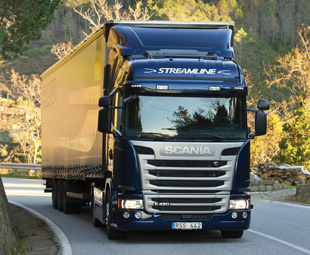Scania streamlines for Euro-6

In his monthly review of global news for local truckers, FRANK BEETON examines Scania’s latest Euro-6-compliant G and R Series trucks, looks at Volvo’s new FM series plus some other new developments from that group, and trawls through Paccar’s latest offerings to the United States’ and European markets.
It was inevitable that the full implementation of the Euro-6 emission standard for all new truck registrations at the end of this year would generate a great deal of new model activity among European truck manufacturers. In recent months, we have seen the complete renewal of Mercedes-Benz’s Continental market model range from Atego upwards, and we are providing details of some new Volvo and Paccar products later in this Global FOCUS. First, however, we look at Scania’s new Streamline series, which takes this manufacturer’s G and R-series long-distance truck-tractors and rigid trucks into the Euro-6 era.
With this range, Scania has made significant efforts to address operator concerns that complying with more stringent emission standards is likely to be accompanied by fuel consumption penalties, and the manufacturer claims that the Streamline models will offer up to eight percent fuel savings in Euro-6 format, or up to five percent in Euro-3, -4 or -5-compliant versions.
Although not radically different in appearance to their predecessors, the Streamline models combine new engine variants with innovative Opticruise automated transmission functionalities and a considerable amount of aerodynamic fine-tuning to achieve the desired economy benefits.
The Euro-6 diesel powerplant line-up includes 9-litre 5-cylinder, 13-litre 6-cylinder and 16-litre V8 configurations, covering the output spectrum from 184 kW (250 hp) to 427 kW (580 hp). (Scania’s top-of-the-range 537 kW/730 hp V8 will be made available in Euro-6 format at a later date.) Euro-6-compliant torque ratings initially range from 1 250 Nm to 2 950 Nm, and emission countermeasures include both Exhaust Gas Recirculation (EGR) and Selective Catalytic Reduction (SCR), although there is one SCR-only 302 kW (410 hp) 13-litre power unit variant that has been specially configured for optimum economy.
The V8 engines are equipped with Scania XPI common-rail fuel injection systems and a rear-mounted variable-geometry turbocharger, and the compressor fitted to all Euro-6 engines disengages automatically when it is not required to deliver air pressure. Two 5-cylinder, 9-litre engine options, adapted to run on biogas, compressed natural gas or liquefied natural gas, are also included in the power unit line-up.
The latest execution Opticruise transmission package incorporates a predictive cruise control function using GPS and topographical map inputs to regulate cruising speed, and a choice of three performance modes to suit prevailing operating conditions from a selection that includes standard, economy, power or off-road settings.
 The various functionalities contained within these modes greatly enhance the vehicle’s ability to optimise performance and economy over a vast range of different operating conditions. The aerodynamic fettling includes smoothing the cab corners, a deflector lip and duct above the headlights to reduce dirt build-up, and a reshaped exterior sun visor, while the cab is also home to new H7 headlights, new seats, an upgraded pullout bed, and an audio system with optional navigation and Bluetooth/USB connectivity. Equipment innovations include a handset-enabled electronic control system for the air suspension, a range of differing capacity AdBlue tanks, a dual-battery system, and an upgraded single-drive rear axle.
The various functionalities contained within these modes greatly enhance the vehicle’s ability to optimise performance and economy over a vast range of different operating conditions. The aerodynamic fettling includes smoothing the cab corners, a deflector lip and duct above the headlights to reduce dirt build-up, and a reshaped exterior sun visor, while the cab is also home to new H7 headlights, new seats, an upgraded pullout bed, and an audio system with optional navigation and Bluetooth/USB connectivity. Equipment innovations include a handset-enabled electronic control system for the air suspension, a range of differing capacity AdBlue tanks, a dual-battery system, and an upgraded single-drive rear axle.
Interestingly, Scania first used Streamline branding during its 100th Anniversary year of 1991. This was applied to a restyled and aerodynamically refined 3-Series truck which was able to return a fuel consumption improvement of four to five percent over its standard siblings. Other features introduced at that time included a 400 hp turbocompound 11-litre engine, a 500 hp V8, and new generation 8-, 9-, 12- and 14-speed gearboxes. Later Scania innovations included a retarder with integrated braking and automatic downhill speed control in 1993, and the introduction of the Opticruise automated transmission range in 1995.
This latest Streamline series has adopted an effective integrated approach to the solution of environmental challenges that go way beyond the simple beefing-up of emission control devices. While the degree of electronic intervention in controlling vehicle functionality may be a matter of growing concern to some operators, it has clearly become a non-negotiable in complying with First World environmental requirements in the 21st century!
Volvo developments
The launch of the revolutionary new FH flagship range by Volvo Trucks last September was one of the major industry talking points of 2012. Key focus was undoubtedly on its pioneering combination of “Individual Front Suspension” and rack-and-pinion steering, but the line-up also bristled with many other innovative features, as was befitting of the premier range from one of the world’s leading truck manufacturing groups.
However, the ramifications of Euro-6 implementation permeate more deeply than just to premium payload line-haul vehicles, and Volvo has also announced significant changes to its medium-height cab FM line-up, which is due to enter production this September. In order to ensure that this range is not overlooked in all the hype that has been directed at its FH “big brother”, the FM range has been tasked as the launch platform for Volvo’s new “Dynamic Steering” system, which is claimed to further reduce driver effort and fatigue over conventional power steering, and provide exceptional on-highway directional stability.
The Dynamic Steering system combines an electric motor generating 25 Nm of torque and an electronic control unit with hydraulic power steering. It also provides automatic self-centring when reversing, compensates for heavily cambered roads and side winds, and minimises the impact of road surface cracks and potholes. The 8×2 versions of the FM are now also each equipped with three steering axles, with one at the front and two at the rear on the tridem rear bogie version, and two at the front and one at the rear in the more familiar configuration employing two axles at the front and a tandem bogie at the rear.
The FM series is offered with a full range of Euro 6-compliant Volvo 11- and 13-litre diesel engines, covering the power spectrum from 260 kW to 375 kW (350 to 500 hp). The latest version of Volvo’s I-Shift automated transmission also has updated I-See predictive technology to optimise gear shifting, speed and auxiliary braking.
Driver comfort and convenience have been enhanced through the provision of a new dashboard with angled instrument panel, a new driver’s seat with additional adjustments, a radar/camera based driver alert and assistance system, and an optional wireless remote vehicle-function control working together with a mobile phone app to reduce the required frequency of driver mounts/dismounts.
The FM will also be available with the telematics-enabled technology, originally announced for the FH, which uses a GSM-enabled online monitoring system to relay parameters such as brake and clutch wear, battery and air drier filter condition to the servicing workshop. This allows for more flexible scheduling of servicing and maintenance, and also provides the functionality to adjust fuel consumption inputs “on the fly”.
 The regular intensification of First World emission controls as typified by Euro-6 implementation, and the volatility of international oil prices, has prompted vehicle manufacturers and operators to actively explore alternative fuel types. Volvo Trucks has been busy in this field, and over the past two years we have reported on development work done by this manufacturer, including the launch of its 13-litre FM MethaneDiesel series model which runs on a variable combination of diesel fuel and up to 75 percent methane, made up of either biogas or Liquefied Natural Gas (LNG).
The regular intensification of First World emission controls as typified by Euro-6 implementation, and the volatility of international oil prices, has prompted vehicle manufacturers and operators to actively explore alternative fuel types. Volvo Trucks has been busy in this field, and over the past two years we have reported on development work done by this manufacturer, including the launch of its 13-litre FM MethaneDiesel series model which runs on a variable combination of diesel fuel and up to 75 percent methane, made up of either biogas or Liquefied Natural Gas (LNG).
Volvo claims that this methane-diesel technology reduces CO2 emissions by up to 70 percent, and makes gas-fuelled operation over longer distances a practical proposition. The latest progression of this technology direction is the announcement that Volvo and Shell are to work together on promoting the use of LNG fuelled trucks in Central Europe and the United States (US). The petroleum company’s contribution will be to provide the manufacturing and supply infrastructure which will facilitate wider usage.
Finally, Volvo Trucks has also introduced a new heavy-haul truck-tractor model to its unique North American product line-up at the 2013 Mid-America Trucking Show. Recognising the continuing and uncompromising preference for conventional (normal control) configuration heavy trucks on that continent, Volvo has developed an indigenous model range in order to be fully competitive in the local market, and these are assembled in Dublin, Virginia.
The latest derivative, designated Volvo VNX, is available in 6×4 and 8×4 configurations, and is intended for extreme and long-combination operations grossing at up to 102 tonnes, in applications such as heavy equipment haulage, movement of aggregates, low-loader operations, logging, oil field servicing and mining.
The driveline specification includes Volvo’s 16-litre D16 engine rated at 450 kW (600 hp), I-Shift automated transmission, parabolic leaf front suspension, a choice of standard, dual-track or wide-track rear tandem-drive bogies, optional steerable pusher axle, raised ride height and full-size day cab.
It is interesting to note that the launch announcement for this new model lists only an in-house Volvo power unit, with no mention of a Cummins-built alternative. Historically, models in the VN line-up could be ordered with a Cummins ISX 15 or a selection of Volvo’s own engines, however, it is to be expected that the manufacturer will try to influence US operators to move away from their traditional “kit-truck” orientation, and increasingly accept “vertically-integrated” product, in which as many aggregates and components as possible are sourced from the parent brand. The VNX order book is scheduled to open during the US autumn of 2013.
Paccar goes Euro-6
American truck manufacturing group Paccar Inc. has major exposure to the European market through its DAF Trucks NV subsidiary, which also happens to be the development source for its in-house global engine programme. It follows, therefore, that Paccar has updated its DAF products and has also revealed details of compliant MX-13 and MX-11 engines ahead of the final Euro-6 implementation date.
Before examining the product details, however, it is interesting to note Paccar’s statement that “a quarter of the Kenworth and Peterbilt trucks supplied in the US since summer 2010 are equipped with the six-cylinder 12,9-litre Paccar MX engine with EPA 10 specification. This engine complies with the current North American legislation, which has similar emission values to those set out in Euro-6″. This confirmation of Paccar’s progress in swinging its US customer base away from their traditional “kit-truck” acquisition philosophy neatly supports Global FOCUS’s long-running prediction of an emerging trend towards “vertically-integrated” products, and clearly illustrates the benefits of sharing major components across global ranges.
DAF’s Euro-6 programme is centred on its latest generation XF flagship truck-tractor, which was launched at last year’s Hannover show. The principal changes made to this well-established and successful product include a new chassis, Euro 6-compliant MX engine, more aerodynamic exterior, and upgraded interior. The chassis improvements include a more efficient component and AdBlue tank layout which has resulted in the availability of increased fuel tank capacities of up to 1 500 litres.
Potential operating cost benefits are made possible through the extending of service intervals up to 150 000 km, new driveline gear ratios, and electronic aids for greater driver efficiency. The SR 1344 single drive 44-tonne GCM rear axle has reduced mass, being carried on a revised suspension with integrated anti-roll characteristics, has reduced 10 litre oil capacity, final drive ratios down to 2,38:1, and a low noise level. Other chassis refinements include improvements to the fifth wheel mounting plate, battery boxes and steering gear.
Cab interior enhancements include new seats, a multi-function steering wheel, a new dashboard with large screen display, larger beds, improved visibility and larger mirrors. Exterior changes include enhanced aerodynamics, a large new grille, a galvanised steel bumper, new mudguards, side fenders, skirts and roof spoiler. The lighting package includes LED headlights and daytime running lights, while active cornering lights are offered as an option.
Safety and convenience functionality include vehicle stability control, adaptive cruise control, forward collision warning, and advanced emergency braking, while the reinforced cab structure provides greater occupant protection through the building in of pre-programmed front and rear crumple zones.
The XF’s 12,9-litre Paccar MX-13 engine has achieved Euro-6 compliance through the adoption of the latest
2 500 bar multiple-event common-rail fuel injection technology, a variable-geometry turbocharger, a combination of EGR, SCR and active soot filter emissions countermeasures, and a new compact graphite iron cylinder block with integrated fuel pressure pumps and piping.
Power outputs range from 300 kW (400 hp) to 375 kW (500 hp), and torque ratings from 2 000 to 2 500 Nm. More recently, Paccar has also announced a Euro 6-compliant version of the smaller displacement 10,8-litre, MX-11 engine, developing power in the 215 to 330 kW (290 to 440 hp) range. The detailed features of this DOHC engine are similar to those described above for the 13-litre unit, and it will be offered in DAF’s CF and XF series vehicles, as well as Kenworth and Peterbilt models from 2015 onwards.
ZF-derived transmission choices for the Euro-6 XF include manual, direct-drive 12-speed or 16-speed synchromesh units with “Servoshift” gear-change assistance, or automated AS-Tronic gearboxes. These have been given specific DAF functionalities which result in smoother operation, EcoRoll, which engages neutral on gentle descents, and Fast Shift, which effects clutchless changes between the eleventh and twelfth speeds, providing improved drive continuity and optimising fuel economy. The XF is also available with Intarder 3, an integrated transmission retarder providing up to 500 kW of braking power.
Global FOCUS is a monthly update of international news relating to the commercial vehicle industry. It is compiled exclusively for FOCUS by Frank Beeton of Econometrix.
Published by
Focus on Transport
focusmagsa




